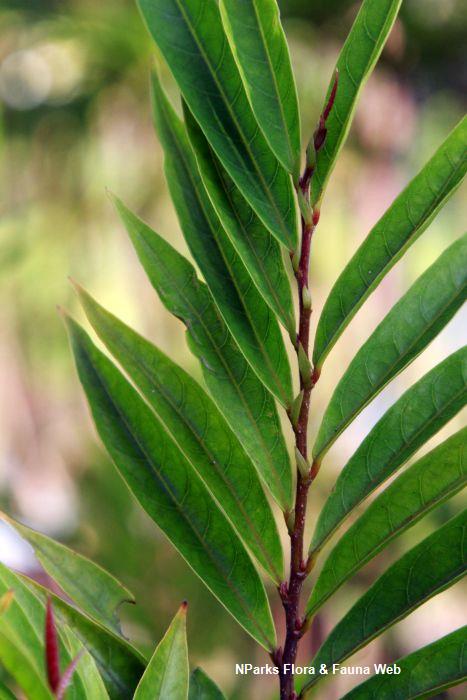_lowres.jpg)
Back
Antidesma ghaesembilla Gaertn.
| Family Name: | Phyllanthaceae |
| Synonyms: | Antidesma ghaesembilla Mull.Arg. var. genuinum, Antidesma ghaesembilla (Willd.) Mull.Arg. var. paniculatum, Antidesma ghaesembilla (C.Presl.) Mull.Arg. var. vestitum, Antidesma paniculatum Willd., Antidesma pubescens Roxb., Antidesma vestitum C.Presl. |
| Common Name: | Andarupis, Anjarubi, Anjuripes, Borotindik, Dempul, Guchek, Gunchin, Gunipot, Indarupis, Jantik-jantik, Kakapal, Lonang, Ondurupis, Sunsuron, Tandurupis, Tarat, Tendrupis, 方叶五月茶 |
Name
Classifications and Characteristics
| Plant Division | Angiosperms (Flowering Seed Plants) (Dicotyledon) |
|---|---|
| Plant Growth Form | Tree (Medium (16m-30m)) |
| Lifespan (in Singapore) | Perennial |
| Mode of Nutrition | Autotrophic |
| Plant Shape | Irregular |
| Maximum Height | 20 m |
| Tree or Palm – Trunk Diameter | 22 cm |
Biogeography
| Native Distribution | From India, Nicobar Islands, Sri Lanka, Bangladesh, to China and Nepal, south throughout Southeast Asia (Cambodia, Indonesia, Laos, Malaysia, Myanmar, Philippines, Thailand, Vietnam) and east to Papua New Guinea and northern Australia. |
|---|---|
| Native Habitat | Terrestrial (Secondary Rainforest, Monsoon Forest, Grassland / Savannah/ Scrubland, Disturbed Area / Open Ground) |
| Preferred Climate Zone | Tropical, Sub-Tropical / Monsoonal |
| Local Conservation Status | Non-native (Horticultural / Cultivated Only) |
Description and Ethnobotany
| Growth Form | It is a tree, up to 20 m tall, with pubescent young twigs. |
|---|---|
| Foliage | Its stalked, alternately arranged leaves are papery to thinly leathery, covered with fine hairs, oblong in shape (sometimes ovate or drop shaped), 3-7 cm long by 3-5 cm wide. The leaf base is rounded to heart-shaped while the leaf tip is usually rounded. |
| Flowers | Its tiny yellow-green to yellow-red flowers are borne on branched axillary or terminal inflorescences axillary and terminal. The plant is dioecious, bearing female and male flowers on different trees. The male inflorescenes are longer, about 4-8 cm long, while the female inflorescenes are shorter, about 2-3 cm long but become longer when developing fruits. The male flowers are stalkless while the female flowers are stalked. |
| Fruit | Its small fruits are fleshy ellipsoid drupes that are somewhat flattened, 3-4 mm long by 2.5-3 mm wide, ripening red. |
| Habitat | It grows in lowland deciduous or evergreen forests, often also in open, disturbed areas and grassland. |
| Associated Fauna | Its flowers are insected pollinated. The fruits are eaten by birds. |
| Cultivation | It can be propagated by seed. |
| Etymology | Greek anti, against; Greek desmos, band; Latin ghaesembilla, after the local name of the plant species in Sri Lanka. |
| Ethnobotanical Uses | Edible Plant Parts : Edible Fruits Medicinal: The leaves are eaten to treat headaches, while the stems are used to facilitate menstrual flow. The fruits are used as laxatives. |
Landscaping Features
| Landscaping | It is suitable for planting in parks and gardens for its attractive fruits and medicinal value. |
|---|---|
| Landscape Uses | Parks & Gardens, Small Gardens |
Fauna, Pollination and Dispersal
| Pollination Method(s) | Biotic (Fauna) |
|---|---|
| Seed or Spore Dispersal | Biotic (Fauna) |
Plant Care and Propagation
| Light Preference | Full Sun |
|---|---|
| Water Preference | Moderate Water |
| Plant Growth Rate | Moderate |
| Rootzone Tolerance | Moist Soils, Well-Drained Soils |
| Propagation Method | Seed |
Foliar
| Foliage Retention | Evergreen |
|---|---|
| Mature Foliage Colour(s) | Green |
| Mature Foliage Texture(s) | Papery, Leathery |
| Foliar Type | Simple / Unifoliate |
| Foliar Arrangement Along Stem | Alternate |
| Foliar Attachment to Stem | Petiolate |
| Foliar Shape(s) | Non-Palm Foliage (Ovate, Obovate, Oblong) |
| Foliar Venation | Pinnate / Net |
| Foliar Margin | Entire |
| Foliar Apex - Tip | Rounded |
| Foliar Base | Cordate |
Floral (Angiosperm)
| Flower & Plant Sexuality | Unisexual Flowers , Dioecious |
Fruit, Seed and Spore
| Mature Fruit Colour(s) | Red |
|---|---|
| Fruit Classification | Simple Fruit |
| Fruit Type | Fleshy Fruit |
Image Repository
Others
| Master ID | 29236 |
|---|---|
| Species ID | 3545 |
| Flora Disclaimer | The information in this website has been compiled from reliable sources, such as reference works on medicinal plants. It is not a substitute for medical advice or treatment and NParks does not purport to provide any medical advice. Readers should always consult his/her physician before using or consuming a plant for medicinal purposes. |









